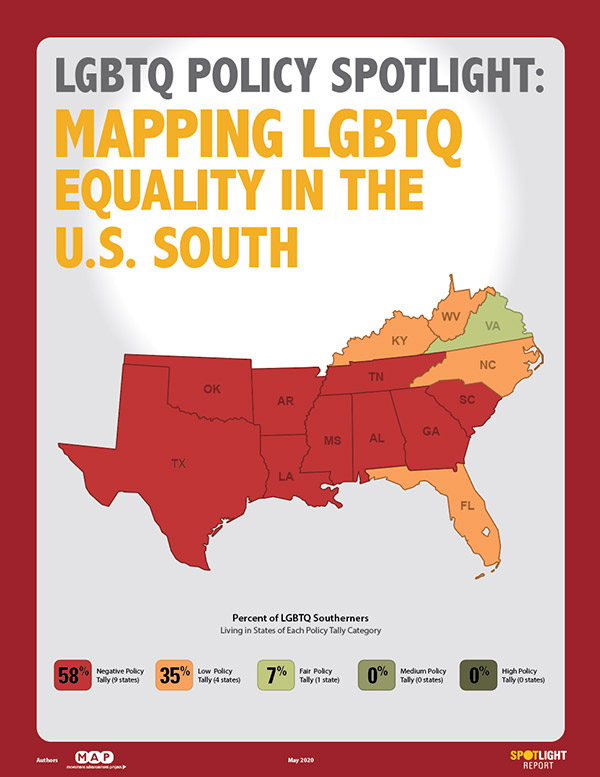More LGBTQ people live in the U.S. South than in any other region of the United States. But for the one in three LGBTQ adults who call the South home, the South is the most hostile LGBTQ state policy landscape in the country. The Movement Advancement Project (MAP) released a new report,
LGBTQ Policy Spotlight: Mapping LGBTQ Equality in the U.S. South, which details how a dearth of progressive laws and policies in 14 Southern states has led to distinct challenges along with unique opportunities for advancing legal equality for LGBTQ people in the region.
This report is released in partnership with
PRIDELAND, a new Public Broadcasting Service (PBS) digital series and television special that follows queer actor Dyllón Burnside on a journey across the South to meet diverse members of the LGBTQ community. From a lesbian rodeo champ in Texas to an African American mayor ally in Alabama, he discovers how LGBTQ Americans are finding ways to live authentically and with pride in the modern South.
MAP’s southern policy tally aggregates nearly 40 LGBTQ-related laws and policies into a concise yet comprehensive way to gauge the LGBTQ-related policy landscape in the region. Compared to the Northeast, West, and Midwest regions, the South has more harmful LGBTQ laws than any other region—whether in criminal justice, religious exemptions, or laws targeting transgender youth—and fewer positive laws than any other as well.
While these challenges show the significant work remaining in the South, Southern states have made progress over the last decade due to the intersectional and coalitional model of Southern LGBTQ advocacy. However, the findings presented in the report illustrate how an LGBTQ person’s legal rights and protections in the South exist in extremely hostile policy climates at the state and local levels, even in 2020. It is critical that advocates for Southern LGBTQ equality continue to work for progress in cities and counties, in state legislatures, and in the halls of Congress.
LGBTQ Policy Spotlight: Mapping LGBTQ Equality in the U.S. South (PDF)Download Equality Maps (Updated in Real Time)Visit PRIDELAND Television SpecialWatch PRIDELAND Episode 1: “Out, Proud & Southern: Dyllón Burnside’s Story”Watch PRIDELAND Episode 2: “An Openly Gay Pastor's Journey to Acceptance in the Bible Belt”Watch PRIDELAND Episode 3: “Polyamory, Demisexuality, and Being Transgender in the South”Watch PRIDELAND Episode 4: “Fighting for Same-Sex Adoption in the South”Watch PRIDELAND Episode 5: “Championing LGBTQ+ Healthcare in Mississippi”Watch PRIDELAND Episode 6: “What Does It Mean To Be An Ally? One Mississippi Baker’s Story”Watch
Recommended citation:
Movement Advancement Project. May 2020.
LGBTQ Policy Spotlight: Mapping LGBTQ Equality in the U.S. South.
www.lgbtmap.org/regional-south-tally. [Date of access].


